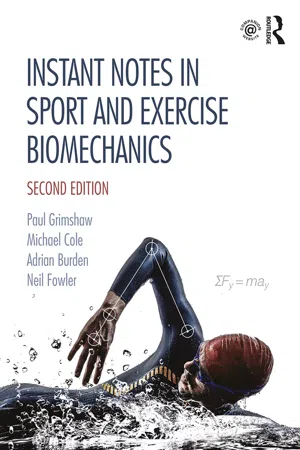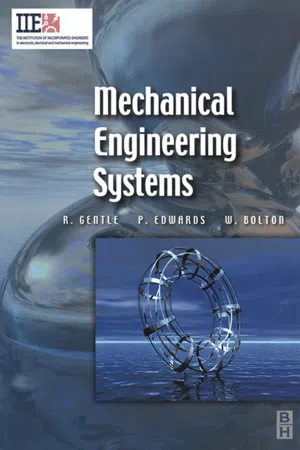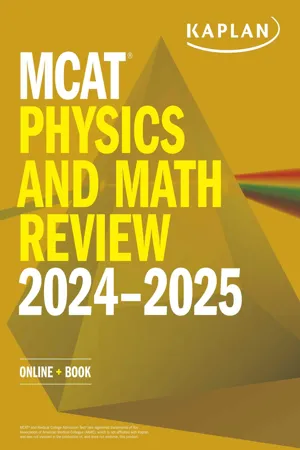Mathematics
Kinematics
Kinematics is the branch of physics that deals with the motion of objects without considering the forces causing the motion. It focuses on describing the position, velocity, and acceleration of objects over time, using mathematical equations and graphs. In mathematics, kinematics is often used to study the motion of particles and systems.
Written by Perlego with AI-assistance
Related key terms
8 Key excerpts on "Kinematics"
- eBook - ePub
- A. L. Stanford, J. M. Tanner(Authors)
- 2014(Publication Date)
- Academic Press(Publisher)
2 Particle Kinematics Publisher Summary This chapter provides an overview of particle Kinematics. Kinematics is the branch of mechanics that describes the motion of physical bodies. It is distinguished from dynamics, which considers relationships between the motions of physical bodies and the forces (pushes or pulls) that are associated with those motions. The chapter also discusses models of physical bodies that may be considered mathematical points for the purpose of mathematical and physical analyses. A physical body may be regarded as a particle when only its translational motion is being considered, that is, when any vibrations or rotations of the body are of no consequence to the problem at hand. Large or small bodies may be treated as particles. The earth in its orbit or an automobile moving along a highway may each be thought of as a particle, provided the interest lies in its translational motion only. Perhaps the simplest example of Kinematics is the motion of a particle constrained to move along a straight line. The speed of the particle at any instant is how fast the particle is moving at that instant. Its speed at a given instant is equal to the distance the particle would traverse each second if it proceeded at the rate it is moving at the given instant. Kinematics is the branch of mechanics that describes the motion of physical bodies. It is distinguished from dynamics, which considers relationships between the motions of physical bodies and the forces (pushes or pulls) that are associated with those motions. For the present we shall be interested in the Kinematics of particles, models of physical bodies that may be considered mathematical points for the purpose of mathematical and physical analyses. A physical body may be regarded as a particle when only its translational motion is being considered, that is, when any vibrations or rotations of the body are of no consequence to the problem at hand. Large or small bodies may be treated as particles - eBook - ePub
Instant Notes in Sport and Exercise Biomechanics
Second Edition
- Paul Grimshaw, Michael Cole, Adrian Burden, Neil Fowler(Authors)
- 2019(Publication Date)
- Garland Science(Publisher)
SECTION A Kinematics of linear motionPassage contains an image
A1 LINEAR MOTION Paul Grimshaw Biomechanics can be defined as the study of forces and the effects of these forces on living things. In mechanics, further subdivision includes Kinematics and kinetics . Kinematics is the study of displacement, velocity and acceleration (spatial and temporal) while kinetics examine forces, moments and torques. Biomechanics and mechanics are used extensively to study human motion. Figure A1.1 defines biomechanics and Kinematics in more detail.Human movement can often be classified into components of linear and angular motion . This leads to a description that is termed general motion. Linear motion (or translation) is movement along a line which may be either straight or curved and where all the body parts are moving in the same direction at the same speed. This can be classified as either rectilinear motion (motion along a straight line) or curvilinear motion (motion along a curved line). Angular motion (discussed elsewhere in this text) involves movement around an axis (either imaginary or real) with body parts (or individual body parts) moving through angles (the same or different angles) in a certain time frame (Figure A1.2 ).Linear Kinematics deal with quantities that describe the motion of bodies such as distance , displacement , speed , velocity and acceleration . These can be classified as either scalar or vector quantities. Scalar quantities are represented by magnitude (size) only, whereas vector quantities possess both magnitude and direction. Vector quantities are represented mathematically, as a symbol with a direction sign or graphically by scaled straight lines or arrows. For example, speed is defined as the distance travelled per unit of time (i.e. 12 m/s (metres per second) or 26.8 mph (miles per hour)) - David V. Guerra(Author)
- 2023(Publication Date)
- CRC Press(Publisher)
7 Kinematics
DOI: 10.1201/9781003308065-77.1 Introduction
Thus far in this volume, the motion of the objects analyzed was simply at rest or in the case of the magnetic force, moving at a constant speed at one instant of time. The techniques applied to analyze a situation were centered around the analysis of vectors. A diagram was produced, vector components were found, an expression was applied, and solutions were found.At this point in the volume, the topic of Kinematics, which is the terminology and the analysis employed to study the motion of objects, is introduced. The solutions to the problems in this chapter are associated with the definitions of different types of motion and not focused on the components of force vectors. Therefore, the pattern of analysis established in the previous chapters is not applied in this chapter, but it will return in the next chapter after the terminology and techniques of Kinematics are studied.- Chapter question: A family makes an 800 km trip, strictly eastward, as described in Figure 7.1 . The family travels the first half of the trip distance at 80 km/h, quickly speeds up, and then maintains a speed of 100 km/h for the second half of the trip distance. For this entire trip, is the average speed 90 km/h? This question will be answered at the end of the chapter using the formal mathematical study of motion, called Kinematics, which is the topic of this chapter.
FIGURE 7.1 Family trip.
7.2 Kinematic Definitions
Kinematics, first developed by Galileo, is the formal study of the motion of objects using diagrams, graphs, and equations. In the previous chapters, the analysis employed assumed the objects were either at rest or moving at a constant speed. Situations under these conditions are known as a static, because the forces are balanced. When the forces become unbalanced, accelerated motion results. In this chapter, the terminology used to describe all types of motion is formalized in preparation for subsequent chapters in which the resulting motion of unbalanced force will be studied. This chapter will start with a definition of displacement and then explore velocity and acceleration in both graphical and analytical formats. It is important to realize that the problem-solving techniques employed in this chapter are different than those used in the previous and subsequent chapters, and this is only a brief aside to introduce the terminology and practices of Kinematics.- eBook - ePub
- D. Gordon E. Robertson, Graham E. Caldwell, Joseph Hamill, Gary Kamen, Saunders Whittlesey(Authors)
- 2013(Publication Date)
- Human Kinetics(Publisher)
It is also the starting place for a complete kinematic description of any human motion. In this section, we introduce the kinematic variables of displacement, velocity, and acceleration, all of which describe the manner in which the position of a point changes over a period of time. The mathematical processes of differentiation and integration—the main concepts of calculus—relate these kinematic variables. Displacement is defined as the change in position. Velocity is the time derivative of displacement, defined as the rate of change of displacement with respect to time. Acceleration is the time derivative of velocity, defined as the rate of change of velocity with respect to time. Acceleration is therefore the second derivative of displacement with respect to time. These three kinematic variables can be used to understand the motion characteristics of a movement, to compare the motion of two different individuals, or to show how motion has been affected by some intervention. Sometimes, determining the time derivative of acceleration, called jerk, is desirable to assess the severity of head impacts during car crashes or collisions with surfaces or projectiles. Table 1.2 lists the commonly used kinematic measures and their associated symbols and units in the International System of Units (SI), including angular kinematic variables, which are discussed later. In some situations, acceleration can be measured directly with a device aptly called an accelerometer. Integral calculus is then used to find the velocity and displacement data. Velocity is the first integral of acceleration with respect to time, whereas displacement is the integral of velocity with respect to time. Information on accelerometers is presented later in this chapter, and methods of integration are detailed in the section on the impulse-momentum relationship in chapter 4 - eBook - ePub
- Richard Gentle, Peter Edwards, William Bolton(Authors)
- 2001(Publication Date)
- Newnes(Publisher)
4Dynamics
SummaryThis chapter deals with movement. In the first part the movement is considered without taking into account any forces. This is a subject called Kinematics and it is important for analysing the motion of vehicles, missiles and engineering components which move backwards and forwards, by dealing with displacement, speed, velocity and acceleration. These quantities are defined when we look at uniform motion in a straight line. This subject is extended to look at the particular case of motion under the action of gravity, including trajectories. This chapter also looks at how the equations of motion in a straight line can be adapted to angular motion. Finally in the first half the subject of relative velocity is covered as this is very useful in understanding the movement of the individual components in rotating machinery.In the second part of this chapter we consider the situation where there is a resultant force or moment on a body and so it starts to move or rotate. This topic is known as dynamics and the situation is described by Newton’s laws of motion. Once moving forces are involved, we need to look at the mechanical work that is being performed and so the chapter goes on to describe work, power and efficiency. Newton’s original work in this area of dynamics was concerned with something called momentum and so this idea is also pursued here, covering the principle of conservation of momentum. The chapter extends Newton’s laws and the principle of conservation of momentum to rotary motion, and includes a brief description of d’Alembert’s principle which allows a dynamic problem to be converted into a static problem. - eBook - ePub
- Hiqmet Kamberaj(Author)
- 2021(Publication Date)
- De Gruyter(Publisher)
4 Two- and three-dimensional motionIn this chapter, we will discuss the Kinematics of a particle moving in two and three dimensions. Utilizing two- and three-dimensional motion, we will be able to examine a variety of movements, starting with the motion of satellites in orbit to the flow of electrons in a uniform electric field. We will begin studying in more detail the vector nature of displacement, velocity, and acceleration. Similar to one-dimensional motion, we will also derive the kinematic equations for three-dimensional motion from these three quantities’ fundamental definitions. Then the projectile motion and uniform circular motion will be described in detail as particular cases of the movements in two dimensions.4.1 The displacement, velocity, and acceleration vectors
When we discussed the one-dimensional motion (see Chapter 3 ), we mentioned that the movement of an object along a straight line is thoroughly described in terms of its position as a function of time,x ( t ). For the two-dimensional motion, we will extend this idea to the movement in thex yplane.As a start, we describe a particle’s position by the position vector r pointing from the origin of some coordinate system to the particle located in thex yplane, as shown in Fig. 4.1 . At timet ithe particle is at point P, and at some later timet fit is at the position Q. The path from P to Q generally is not a straight line. As the particle moves from P to Q in the time intervalΔ t =, its position vector changes fromt f−t ir itor f.Definition 4.1 (Displacement vector).
The displacement is a vector, and the displacement of the particle is the difference between its final position and its initial position. We now formally define the displacement vector for the particle as the difference between its final position vector and its initial position vector:(4.1)Δ r =r f−r i.The direction ofΔ ris indicated in Fig. 4.1 from P to Q. Note that the magnitude ofΔ r - No longer available |Learn more
MCAT Physics and Math Review 2024-2025
Online + Book
- (Author)
- 2023(Publication Date)
- Kaplan Test Prep(Publisher)
Now that we’ve covered the basic geometry that serves as the foundation of physics, we can examine the related physical quantities. The basic quantities that relate to Kinematics are displacement, velocity, and acceleration.Displacement
An object in motion may experience a change in its position in space, known as displacement (x or d). This is a vector quantity and, as such, has both magnitude and direction. The displacement vector connects (in a straight line) the object’s initial position and its final position. Understand that displacement does not account for the actual pathway taken between the initial and the final positions—only the net change in position from initial to final. Distance (d) traveled, on the other hand, considers the pathway taken and is a scalar quantity.Example:What is the displacement of a person who walks 2 km east, then 2 km north, then 2 km west, and then 2 km south?Solution:While the total distance traveled is 8 km, the displacement is a vector quantity that represents the change in position. In this case, the displacement is zero because the person ends up back at the start, as shown below.Velocity
As was mentioned earlier, velocity (v) is a vector. Its magnitude is measured as the rate of change of displacement in a given unit of time, and its SI units are meters per second. The direction of the velocity vector is necessarily the same as the direction of the displacement vector. Speed (v) is the rate of actual distance traveled in a given unit of time.The distinction is subtle, so let’s examine this a little more carefully. The instantaneous speed of an object will always be equal to the magnitude of the object’s instantaneous velocity, which is a measure of the average velocity as the change in time (Δt) approaches zero:v =Equation 1.6limΔ t → 0Δ xΔ twhere v is the instantaneous velocity, Δx is the change in position, and Δt - No longer available |Learn more
- Robert A. Pelcovits, Joshua Farkas(Authors)
- 2023(Publication Date)
- Barrons Educational Services(Publisher)
2Kinematics
We begin our discussion of Kinematics with the one dimensional case and then consider two dimensions.Learning Objectives
In this chapter, you will learn:Instantaneous speed, velocity, and accelerationAverage speed, velocity, and accelerationUniformly accelerated motion: freely falling objects, projectile motionRelative position, velocity and accelerationUniform circular motion (UCM)Based on the following three definitions, we will derive all the equations for one-dimensional Kinematics and uniformly accelerated motion (UAM), or constant acceleration, using calculus. All the derivations are posed as questions, and we suggest you attempt them on your own before checking our solutions.Definitions: One Dimension
Instantaneous velocity: Instantaneous speed: Instantaneous acceleration:Note: These are the one-dimensional definitions of velocity, speed, and acceleration. Later in this chapter, we will introduce two-dimensional definitions. For now, no formal vector notation is needed; a value’s sign (+/−) is sufficient to specify direction along one dimension.Velocities and speeds are expressed in length/time (SI units of m/s), and accelerations are expressed in length/time2 (SI units of m/s2 ).Instantaneous speed
Index pages curate the most relevant extracts from our library of academic textbooks. They’ve been created using an in-house natural language model (NLM), each adding context and meaning to key research topics.







